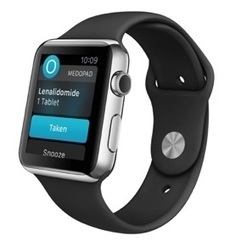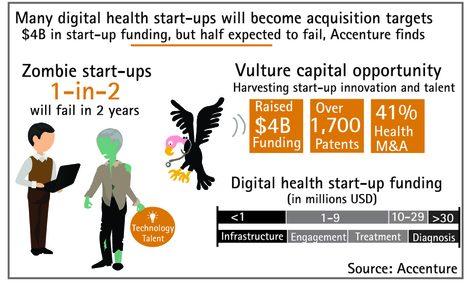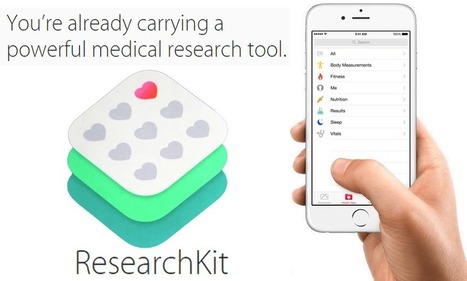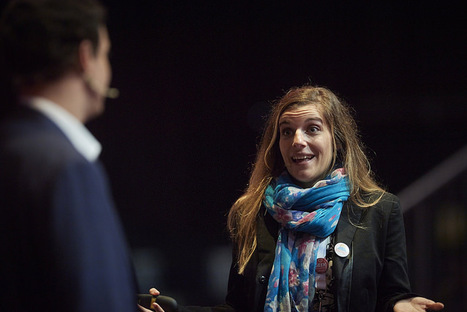 Your new post is loading...

|
Scooped by
Sergio Ariño Blasco
May 9, 2020 1:56 PM
|
Finally, 136 papers were fully evaluated and included in this review, allowing a wide overview of wearable devices for the management of Parkinson's disease.
“A new study says that monitors in Apple Watch and some other wearables can be extremely accurate when it comes to detecting abnormal heart rhythms, in conjunction with the Cardiogram app.”
Via Andy Dé

|
Rescooped by
Sergio Ariño Blasco
from TECNOLOGÍA_aal66
April 11, 2020 6:14 PM
|
“¿La cobertura wifi no alcanza la última planta de la casa? ¿Se corta la red cuando hay varios dispositivos conectados al mismo tiempo? Al caminar, ¿s”
Via Angel Acción Lamas

|
Scooped by
Sergio Ariño Blasco
October 4, 2019 2:08 PM
|
Neurosyphilis Neurosyphilis, the result of invasion of the nervous system by Treponema pallidum, can occur at any time after primary infection and is altered by HIV coinfection. Serologi

|
Scooped by
Sergio Ariño Blasco
August 21, 2019 2:06 PM
|
BACKGROUND Disparities in healthcare access and delivery, caused by transportation and health workforce difficulties, negatively impact individuals living in rural areas. These challenges ar

|
Rescooped by
Sergio Ariño Blasco
from Digital Health
July 22, 2019 12:58 PM
|
A London hospital is the latest to put the Apple Watch to use within its walls, this time to improve medication management and adherence for cancer patients undergoing chemotherapy. According to a report from Wareable, King’s College Hospital will be the first to pilot an app from Medopad, a British company that also makes tablet-based mobile health technology. “Cancer treatment is a challenging journey,” Dr Siamak Arami, a Consultant Haematologist at King’s College Hospital, told The Journal of mHealth last month, when Medopad launched the app. “Adherence to complicated treatment regimens, and the streamlined recording and reporting of health issues during treatment are of paramount value. Medopad’s Apple Watch chemotherapy application is an exciting new development in medical technology that can transform the quality and safety of care for patients, carers and care providers. This can eventually reduce the cost and improve the outcome of treatment for cancer patients.”
Via Alex Butler, Anja Stagge

|
Rescooped by
Sergio Ariño Blasco
from Mobile Healthcare
July 12, 2019 3:47 AM
|
Falling is awful. It causes irreparable harm to senior citizens and the fear of falling reduces senior citizen mobility drastically, creating a feedback loop that can be catastrophic. Now, thanks to a team at the Sinclair School of Nursing and the College of Engineering at the University of Missouri, caregivers can predict falls up to three weeks out, allowing for care and assistance before its needed. The system is non-wearable and uses cameras to assess gait speed and stride length. The researchers found that a “gait speed decline of 5 centimeters per second was associated with an 86.3 percent probability of falling within the following three weeks.” Further, a shortened stride length “was associated with a 50.6 percent probability of falling within the next three weeks.” With these two pieces of data caregivers can intervene before things get out of hand. 122721_web “Aging should not mean that an adult suddenly loses his or her independence,” said Marilyn Rantz, Professor Emerita of Nursing. “However, for many older adults the risk of falling impacts how long seniors can remain independent. Being able to predict that a person is at risk of falling will allow caretakers to intervene with the necessary care to help seniors remain independent as long as possible.” The team based their system at TigerPlace, a retirement residence in Columbia, Missouri. They installed sensors around the location and set up an email alert system “when irregular motion was detected.” It’s a great use of some intelligent technology and, what’s more, it requires no wearables and is completely passive.
Via Chatu Jayadewa

|
Scooped by
Sergio Ariño Blasco
May 26, 2019 5:55 AM
|
Recently, the World Health Organization [2] pointed out the importance of tracking walking speed of older adults over time. In-home sensor-based acquisition of physiological parameters is an interesting approach as it could overcome self-report data limitations and allows objective and ecologically valid assessment. However, it is not clear yet, among the multitude of sensors and devices under evaluation, which ones will provide the best evidence for real-life use and what transformation clinicians might expect in their everyday practices.

|
Scooped by
Sergio Ariño Blasco
April 18, 2019 7:17 AM
|
Leila is an 86-year-old woman with type 2 diabetes and high blood pressure. She lives alone, and, as a result of a recent heart attack, her family doctor and cardiologist want to see her more frequently. She has some moderate arthritis involving her knees and hips and poor vision, but she is committed to maintaining her independence.

|
Scooped by
Sergio Ariño Blasco
April 10, 2019 9:05 AM
|
AKQA – The AKQA Sensekit is designed to empower the one in ten people who suffer sensory impairment – perhaps blind or deaf, or with low vision, or who are hard of hearing. Intended to be developed as a kit comprising various sensors and haptic wearables, this allows users to develop solutions that respond to their unique requirements. Using sensory substitution AKQA’s technology takes data from sensors, then making use of Edge Computing and Microsoft Cognitive Services, transforms that into a signal sent to a discreet haptic wearable. Over time users learn how to interpret vibration patterns from the wearables, so that the brain starts to extract meaning from the vibration to be able to recognise a face or understand a spoken greeting, for example.

|
Scooped by
Sergio Ariño Blasco
April 9, 2019 5:38 PM
|
An independent report on behalf of the Secretary of State for Health and Social Care. The Topol Review makes recommendations that will enable NHS staff to make the most of innovative technologies such as genomics, digital medicine, artificial intelligence and robotics to improve services. These recommendations support the aims of the NHS Long-Term Plan, and the workforce implementation plan, helping to ensure a sustainable NHS.

|
Scooped by
Sergio Ariño Blasco
April 9, 2019 5:23 PM
|
Computed tomography (CT) and magnetic resonance imaging (MRI) scans are chock full of information that might be used to personalize treatment. Unfortunately, this information is not readily available. The latest type of artificial intelligence (AI) algorithms, however, might change that, according to Albert Hsiao, M.D., assistant professor of radiology at the University of California San Diego.
During a scientific session March 16 of this year’s annual meeting (#ACC19) of the American College of Cardiology, Hsiao said he plans to discuss how smart algorithms might extract this information from CT and MRI scans and how its availability could change patient management.
A key takeaway of his presentation, to be given as part of a scientific session titled “Man vs. Machine: Current and Future Applications of Machine Learning in Cardiovascular Imaging,” will be that the “explosive growth” of machine learning has raised “opportunities for tying (this information) directly to patient management,” he said. “This is in large part because of the amazing democratization of machine learning that this new area of ‘deep learning’ has enabled.”
Physicians might use this information to create “imaging phenotypes” of patients. These phenotypes, in turn, might be used to personalize the treatment of patients.
“Information like how much body fat you have, how fat is your liver, how much is your muscle mass — those are rich pieces of information that if quantified could really help us guide and make more specific patient recommendations,” said Hsiao, who seven years ago co-founded Arterys, a modern day provider of cloud-based AI software for medical imaging.
|
“El Content marketing es una técnica efectiva de posicionar tu negocio, captar nuevos clientes y fidelizar los existentes. Veamos de qué se trata y cómo crear una estrategia efectiva de marketing de contenidos. En los próximos apartados conocerás: TABLA DE CONTENIDOS ¿Qué es el Content Marketing? ¿Por qué es importante hacer Content Marketing? ¿Cómo crear…”
Via Juan Jesús Baño Egea
“Ante la situación, y dado que de momento no se sabe durante cuanto tiempo vamos a seguir en estado de alerta, universidades e institutos no ha”
Via José R. Pabón Pagán

|
Scooped by
Sergio Ariño Blasco
March 7, 2020 4:15 AM
|
Any one thought about actually testing this on diabetics? Er, no?
“El Content marketing es una técnica efectiva de posicionar tu negocio, captar nuevos clientes y fidelizar los existentes. Veamos de qué se trata y cómo crear una estrategia efectiva de marketing de contenidos. En los próximos apartados conocerás: TABLA DE CONTENIDOS ¿Qué es el Content Marketing? ¿Por qué es importante hacer Content Marketing? ¿Cómo crear…”
Via Juan Jesús Baño Egea

|
Scooped by
Sergio Ariño Blasco
August 12, 2019 12:54 PM
|
April 24th, Ghana’s first ever medical drone service took its first flight. This drone is unlike any other.As it holds the world record for the biggest...

|
Rescooped by
Sergio Ariño Blasco
from Digital Health
July 22, 2019 12:57 PM
|
“ Even as funding for digital health start-ups is accelerating, a new report from Accenture (NYSE:ACN) forecasts that one out of every two of these new companies is likely to fail within two years of launch – but that larger companies could mine these “zombie” start-ups for talent or innovative technologies. “Rather than discard the investment that has been made in getting sputtering start-ups off the ground, it often makes sense for healthcare stakeholders to acquire them, salvage their best people and technologies and awaken them from a zombie-like existence,” said Kaveh Safavi, managing director for Accenture's global healthcare business. “Many digital start-ups that are dying or in danger of failure have developed solutions that can help traditional and non-traditional healthcare companies achieve their goals.” ”
Via Alex Butler, Anja Stagge

|
Scooped by
Sergio Ariño Blasco
July 6, 2019 2:58 AM
|
Dicen, digo, que estamos ante una revolución en la tecnología de comunicación. Y como la comunicación es la esencia de nuestra capacidad cognitiva, se espera, y algunos predicen, un impact
This Viewpoint discusses the costs of emerging therapies for conditions prevalent in the US Baby Boomer population now entering old age and proposes principles to ensure the value and accessibility of new expensive drugs including cost-effectiveness (CE) assessments, price-benefit alignment

|
Scooped by
Sergio Ariño Blasco
April 16, 2019 9:52 AM
|
Solving for problems in medicine is not the same as software engineering, but that doesn't mean algorithms have no role to play. Instead of asking algorithms in medicine to learn from humans and reproduce human judgment — including biases — what if we asked them to learn from nature?
“ medical researchers all over the world will now be able to use ResearchKit to develop their own apps and developers can also contribute new research modules”
Via Celine Sportisse, Clara Hamelin

|
Scooped by
Sergio Ariño Blasco
April 9, 2019 5:37 PM
|
This paper commissioned by NHS Digital looks at the clinical, ethical and practical concerns relating to artificial intelligence (AI) use in the health and social care system. It provides a snapshot of 12 domains that will be most impacted by AI and looks at each from a clinical, ethical and practical perspective. The report makes seven key recommendations and warns that AI is not likely to solve all the problems faced by the health care system.
“After attending the 4YFN (four years from now) at the Mobile World Congress in Barcelona recently, digital health entrepreneur and nurse Anna Sort outlines four key predictions for the healthcare of the future.”
Via Florian Morandeau, Lionel Reichardt / le Pharmageek
|



 Your new post is loading...
Your new post is loading...





























